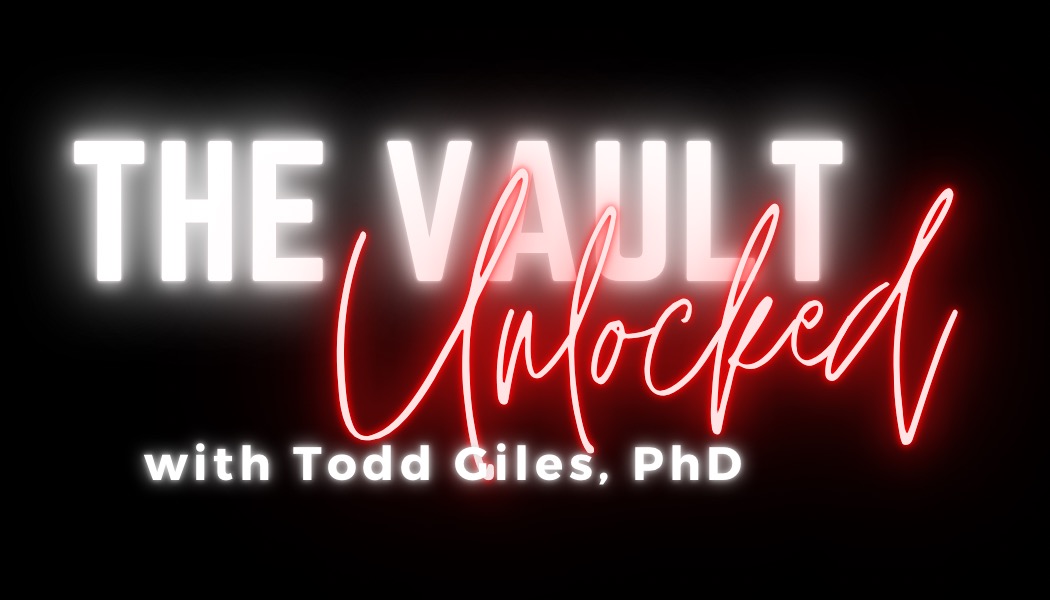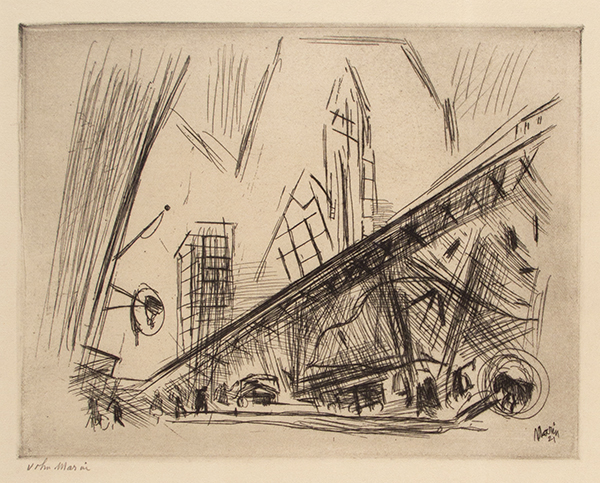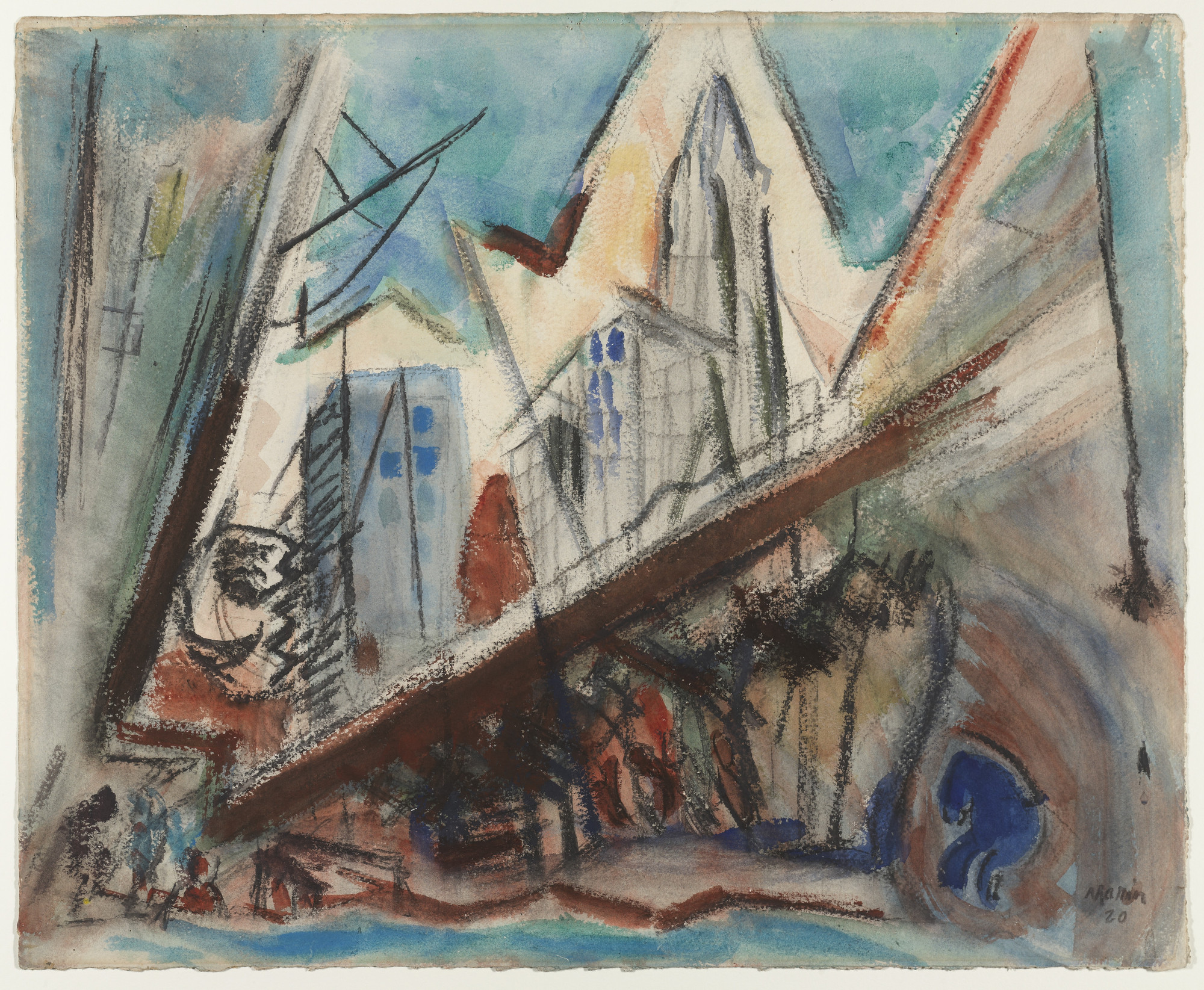
Ever wonder where the art is stored at the WFMA, and what's in there anyway? Join MSU professor Todd Giles as he unlocks the vault!

John Marin
Downtown, The El, 1921
Etching
6 3/4” x 8 9/16”
Signed in pencil
Museum purchase, 1977
“The whole city is alive; buildings, people, all are alive; and the more they move me the more I feel them to be alive.”
~ John Marin, from Alfred Stieglitz’s Camera Work (1913)
[Transcript]
Hello and welcome to The Vault Unlocked. My name is Todd Giles and we’re here to take you inside the collection vault at the Wichita Falls Museum of Art at MSU Texas, because getting to know art helps us better know ourselves. In this episode, we will take a close look at John Marin’s 1921 etching, Downtown, The El.
John Marin (1870–1953) was perhaps the most famous American Modernist working in the early twentieth century. Even art critic Clement Greenberg, one of the most vocal proponents of post-World War II Abstract Expressionism, referred to Marin as late as 1948 as “the best painter alive in America at this moment” (O’Brian 268).
Like many up-and-coming artists of his day, Marin studied briefly at the Pennsylvania Academy of the Fine Arts in Philadelphia, where several other artists in the WFMA’s permanent collection attended, such as George Pennell, Charles Sheeler, and William Glackens, to name a few. And like many of our nation’s artists, writers and composers, Marin left the US to study in Europe in 1905 at the age of 35. Also like several other artists of his day, Marin was an unemployed architectural draftsman who taught himself to etch to earn a living. While in Paris, he met who was to become his greatest proponent for nearly four decades, photographer and gallery owner Alfred Stieglitz, who, the following year, gave Marin his first one-man exhibition at Gallery 291 in New York City.
Back in the States in 1910, Marin moved away from the soft atmospheric style of James McNeill Whistler, who influenced just about every American artist touring Europe at the turn of the previous century, to a more expressionistic approach influenced by Fauvism and Cubism. The rapidly developing New York City skyline invited a more fragmented, dynamic and angular vocabulary than did the foggy streets and older architecture of Europe.
By 1913, Marin began a series of etchings of the Woolworth Building, which was completed in that year, and the Brooklyn Bridge; these etchings mark a watershed in Marin’s style and are some of the most interesting prints produced by any American artist of the era. Faced with the fast-pace of development in the city, Marin’s etchings and watercolors capture the energy and dynamism of the Metropolis with a series of energetic slashes, cross-hatching, and squiggles that produce a harried sense of immediacy—they virtually pulse and throb with movement and energy.
 1921 was a big year for Marin: the Metropolitan Museum of Art welcomed its first Marin work into its permanent collection; he also had a one-man exhibition at the E. Weyhe Gallery in New York City, which included thirty-one etchings, six pastels, and five watercolors. That same year, Marin composed Downtown, The El. The version under consideration here is actually the third and final state of the print; it is also one of Marin’s most well-known, as it was later printed in 1924 with works by Edward Hopper and John Sloan (both also represented in the WFMA’s permanent collection) as part of New Republic magazine’s Folio of American Etchings in an edition of 500 as a subscription promotion. It is interesting to compare the final version with the first two states, which progressively move towards abstraction. Also of interest is looking at the etching in conjunction with Marin’s 1920 watercolor titled Lower Manhattan.
1921 was a big year for Marin: the Metropolitan Museum of Art welcomed its first Marin work into its permanent collection; he also had a one-man exhibition at the E. Weyhe Gallery in New York City, which included thirty-one etchings, six pastels, and five watercolors. That same year, Marin composed Downtown, The El. The version under consideration here is actually the third and final state of the print; it is also one of Marin’s most well-known, as it was later printed in 1924 with works by Edward Hopper and John Sloan (both also represented in the WFMA’s permanent collection) as part of New Republic magazine’s Folio of American Etchings in an edition of 500 as a subscription promotion. It is interesting to compare the final version with the first two states, which progressively move towards abstraction. Also of interest is looking at the etching in conjunction with Marin’s 1920 watercolor titled Lower Manhattan.
In Downtown, The El, we see an abstracted Woolworth Building towering behind the elevated rail tracks, a swiftly moving train in the upper right corner. In the lower right, a horse (with carriage not visible in the third state of the print) coming out of the shadows. There also appear to be at least two more carts below the tracks on the street, where we also see the hustle-and-bustle of people moving to-and-fro about their daily business. Another building towers above street level along the left side of the work; here, we see an awning marking the entrance, what in the first state of the print looks like a large globe sign likely telling us who inhabits the building, and higher above, an un-flagged flagpole.
Notice the artist’s energetic lines; notice too that the center of the print is less hazy than the outer portions. This is because Marin liked to start wiping the excess ink from the plate in a circular motion from the center outwards, leaving the edges of the print looking somewhat soft and hazy. Likewise, he intentionally did not wipe the excess ink from the edges of the etching plates so they would leave a “frame” where the edges of the plates were pressed tightly against the paper during the printing process.
All of this—the energetic lines, the move towards abstraction, the “dirty” plates, and the inked frames—add to the immediacy of Marin’s etchings, and, if one were to hazard a guess, this is likewise why Clement Greenberg, who championed the likes of Jackson Pollock and Willem de Kooning in the 1940s and 50s, likewise appreciated the work of their predecessor.
Another critic writing of Marin’s work in 1936, Lewis Mumford, wrote in the New Yorker that “[n]o other contemporary has better caught the beat and tempo of the great city: its crazy exultation and its restless surge, the disordered march of slow beats and fast beats, the dead spots that seem an eternity spent on a stalled subway train, and the live spots, so packed with unmanageable vitality that the juice overloads the circuit and causes a blowout” (qtd. in Koenhauser 57).
Thanks for joining us as we unlock the vault at the Wichita Falls Museum of Art at MSU Texas. To learn more about the WFMA our current and upcoming exhibitions, the permanent collection, as well as sign up for our e-newsletter, visit wfma.msutexas.edu.
Works Consulted
Fern, Alan and Ellen S. Jacobowitz, et al. American Graphics: Selected from the Collection of the Philadelphia Museum of Art. Philadelphia Museum of Art, 1982.
Fine, Ruth. John Main. Abbeyville Press, 1990.
Greenberg, Clement. Clement Greenberg: The Collected Essays and Criticism, Vol. 2, edited by John O’Brian, Chicago UP, 1986.
John Marin Prints: A Retrospective. Kennedy Galleries, NY, 1982.
Koenhauser, Elizabeth Mankin. American Moderns on Paper: Masterworks from the Wadsworth Athenaeum Museum of Art. Yale UP, 2010.
Marin, John. Camera Work, nos. 42-43 (April-July, 1913), p. 18.
Downtown, The El from the Permanent Collection of the Wichita Falls Museum of Art at MSU Texas
View Previous The Vault Unlocked
-
Tuesday - Friday
10:00AM - 5:00PMSaturday
1:00PM - 5:00PM